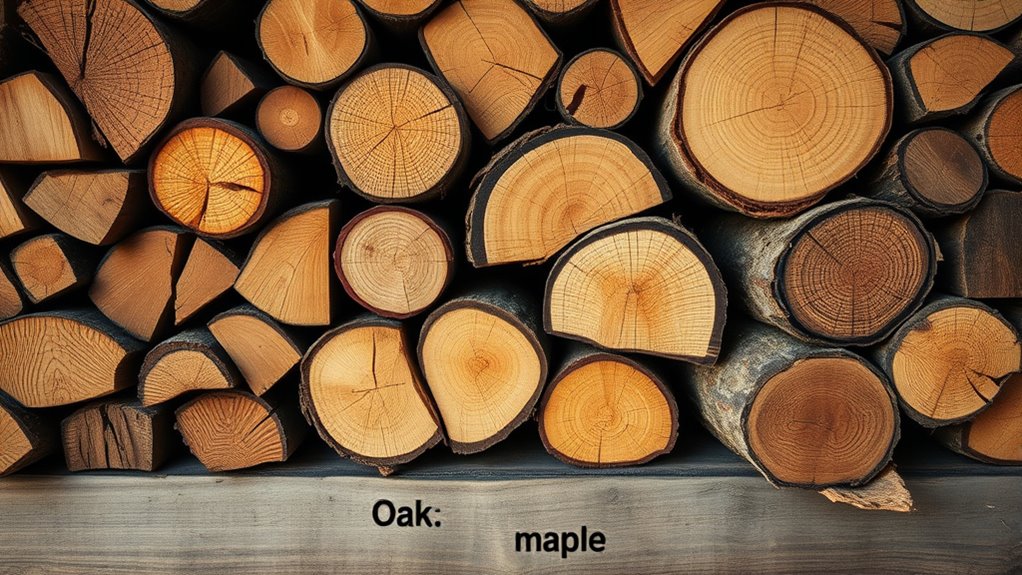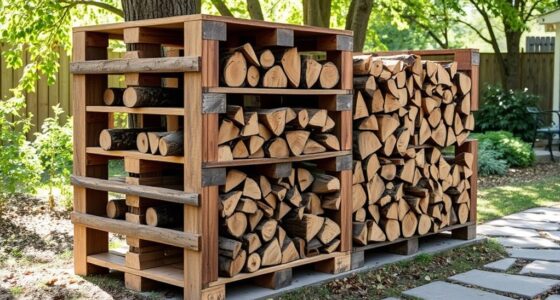Firewood weight charts by species help you estimate how much wood you get per load, factoring in moisture content and type. Hardwoods like oak and hickory are heavier, while softwoods like pine are lighter, especially when seasoned. Moisture profoundly influences weight, with green wood being heavier. Using these charts helps you buy, sell, or store firewood more accurately. Keep exploring to discover practical tips for calculating and managing firewood by species.
Key Takeaways
- Firewood weight varies significantly by species, with hardwoods like oak and hickory being heavier than softwoods such as pine and spruce.
- Weight charts provide specific pounds per cord or per cubic foot for different species, aiding accurate volume estimation.
- Seasoned (dry) firewood weighs less than green (fresh) wood; charts often specify moisture content for precise calculations.
- Using weight charts helps determine proper seasoning levels and manage firewood storage efficiently.
- Species-specific weight data supports better estimation of heating potential and transportation logistics.
Understanding Firewood Density and Its Impact on Weight

Understanding firewood density is crucial because it directly affects how much a specific piece of wood weighs. When evaluating firewood, consider how firewood seasoning influences its density—properly seasoned wood is lighter and burns more efficiently. Wood density factors, such as species, moisture content, and growth conditions, also play a key role. Denser woods contain more fiber and moisture, making them heavier and harder to burn, while less dense woods are lighter and ignite faster. Recognizing these factors helps you estimate weight more accurately and choose the right firewood for your needs. Additionally, high-quality measurement techniques can improve your estimates of firewood weight based on density and seasoning, leading to better efficiency in your firewood use. Properly accounting for firewood moisture content can further refine your weight estimates and burning efficiency. Being aware of relationships between these factors can help you make more informed decisions when selecting and preparing firewood. Understanding firewood density is essential for optimizing your firewood usage and ensuring efficient burning.
Common Hardwood Species and Their Typical Weights

Hardwood species are popular choices for firewood because they burn longer and produce more heat, but their weights can vary considerably. Knowing typical weights helps you compare species and determine how much wood you’ll need. Proper firewood seasoning reduces moisture, which affects weight and burn efficiency. Here’s a quick species comparison:
| Species | Average Weight (per cord) | Notes |
|---|---|---|
| Oak | 4,000 lbs | Dense, slow seasoning |
| Maple | 3,800 lbs | Slightly lighter, good heat |
| hickory | 4,200 lbs | Very dense, great burn |
| Ash | 3,700 lbs | Easier to season, lighter |
This table helps you estimate weights and choose the best species for your needs. Wood density influences the firewood weight significantly and can vary within the same species based on moisture content and growth conditions. Additionally, proper tuning of your firewood storage environment can help ensure optimal seasoning and burning efficiency. Proper storage techniques are essential for reducing moisture content and maximizing heat output.
Popular Softwood Species and Their Weight Ranges

Softwood species are popular for firewood because they tend to be lighter and quicker to season, making them a convenient choice for many users. Common softwoods like pine, spruce, and fir typically weigh between 20 to 30 pounds per cubic foot when dry. Their lighter weight makes handling easier and speeds up firewood seasoning, reducing the time needed before burning. When splitting softwood, you’ll notice it’s generally easier to work with, saving effort and time. However, keep in mind that softwoods burn faster and produce less heat than hardwoods. Knowing the weight range of softwood species helps you estimate how much firewood you’ll be getting per cord, ensuring you have enough for your needs while maintaining proper firewood storage and handling. Additionally, understanding the coastal environment can help in selecting firewood types that are less affected by moisture and weather conditions.
Comparing Moisture Content and Its Effect on Firewood Weight
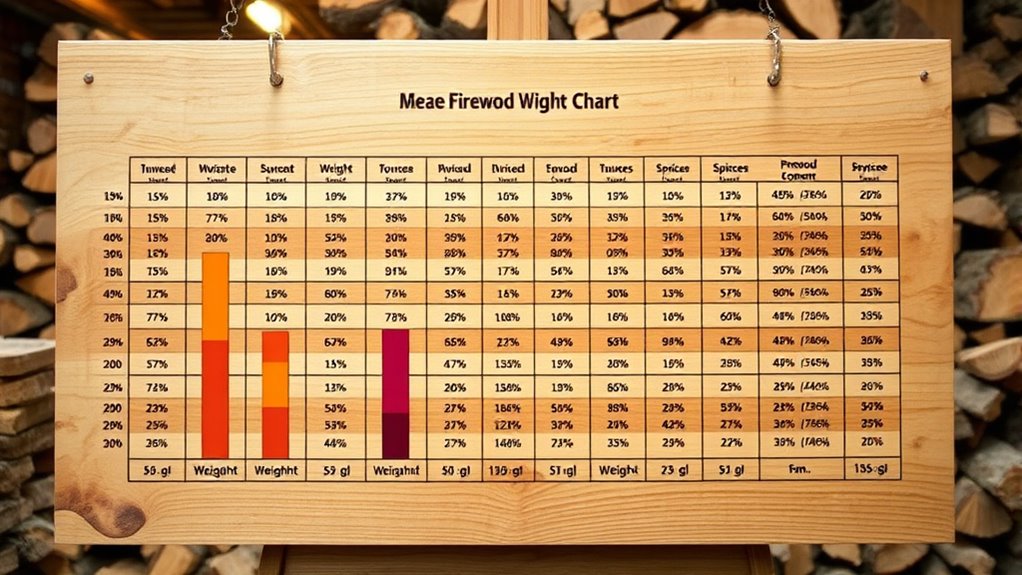
Moisture content has a big impact on firewood weight—you’ll notice wetter wood is considerably heavier. As firewood dries out, it loses moisture and becomes lighter, making it easier to handle and burn efficiently. Understanding this difference helps you estimate how much usable heat your wood will produce. Properly seasoned air quality can also influence how quickly firewood dries and burns. Additionally, maintaining good air circulation around your firewood stack promotes faster drying and reduces mold growth. Using moisture meters can help you determine when firewood has reached optimal dryness for burning. Incorporating market trends can also inform you about the best types of firewood for your climate and needs.
Moisture Impact on Weight
Since moisture content considerably influences firewood weight, understanding its impact is essential when estimating how much wood you’ll actually be getting. Higher moisture increases weight, leading to significant weight variation. Dry wood can weigh up to 30% less than green, unseasoned wood of the same volume. Monitoring moisture content helps you estimate the true weight and energy value of your firewood. For optimal performance, properly seasoning your wood reduces moisture content and weight. A crochet technique can also be used to create protective covers that help maintain proper moisture levels during storage. Additionally, using a moisture meter allows for accurate measurement of the wood’s moisture content, ensuring better control over the seasoning process. Being aware of the trustworthiness of brands can also help you select high-quality tools like moisture meters for consistent results.
Drying Reduces Mass
Drying firewood considerably decreases its mass, making it easier to handle and transport. When you use seasonal storage methods, you allow moisture to escape naturally, reducing weight over time. Proper drying guarantees you measure moisture content accurately through moisture measurement tools, helping you determine when firewood is sufficiently seasoned. As firewood dries, its moisture content drops from green or wet levels to the ideal range for burning, markedly lowering its weight. This reduction not only eases transportation but also improves combustion efficiency. Keep in mind that freshly cut wood may weigh twice as much as seasoned wood. Additionally, understanding moisture content is essential for selecting properly seasoned firewood and ensuring optimal burning conditions. Recognizing the benefits of proper drying can lead to more efficient use of firewood and better heat output. Properly dried firewood also contributes to reducing emissions, promoting cleaner combustion and environmental benefits. Moreover, the seasonal drying process plays a crucial role in achieving optimal moisture levels for safe and effective fires. Implementing AI security measures in storage and handling systems can further safeguard this valuable resource.
How to Use Weight Charts for Buying and Selling Firewood
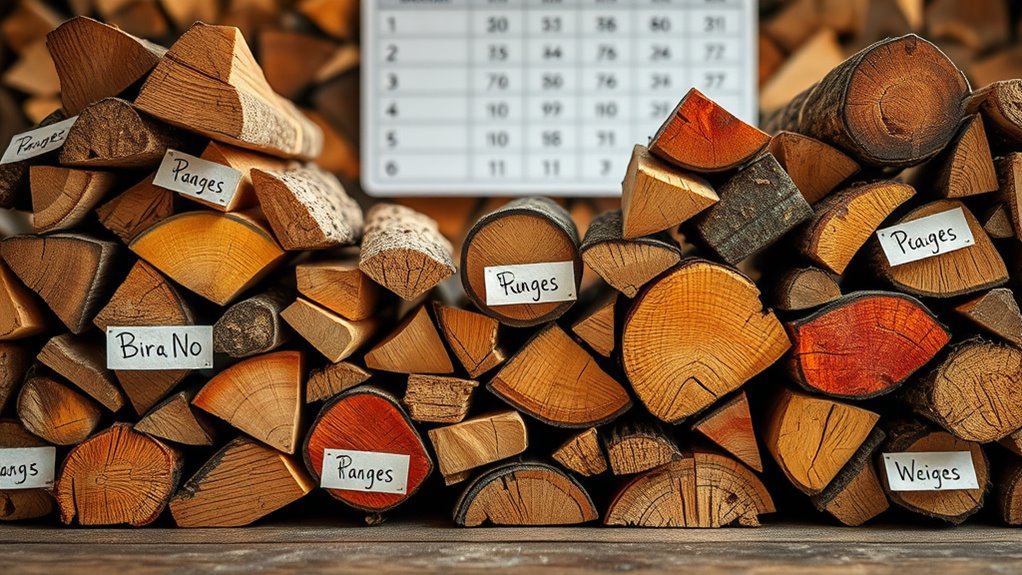
Using weight charts effectively can help you make informed decisions when buying or selling firewood. First, verify the firewood has undergone proper seasonal drying, which reduces moisture content and improves accuracy. Next, measure moisture levels with a moisture meter to confirm the wood’s dryness, as wet wood weighs more and skews weight estimates. Finally, compare the weight of the firewood to the chart for its species, considering if it’s seasoned or green. Visualize these steps:
- You hold a bundle of firewood, noting its weight.
- You measure moisture to confirm it’s properly dried.
- You consult the weight chart to determine if the weight aligns with quality standards.
Following these steps ensures fair transactions based on reliable weight data.
Estimating Firewood Volume From Weight Measurements

To estimate firewood volume from weight measurements, you need to understand the relationship between weight and volume for different wood species. Seasonal weight fluctuations, caused by moisture content changes, can affect your estimates, so it is crucial to account for whether the wood is green or seasoned. Using firewood compression techniques helps maximize density, making weight a more accurate indicator of volume. Remember, freshly cut wood weighs more due to higher moisture, while dried wood is lighter. By knowing the typical weight per cord or per load for each species, you can convert your measurements into volume estimates more reliably. This approach allows you to gauge how much firewood you have, even without directly measuring its dimensions, streamlining your firewood management process.
Tips for Handling and Storing Firewood by Species
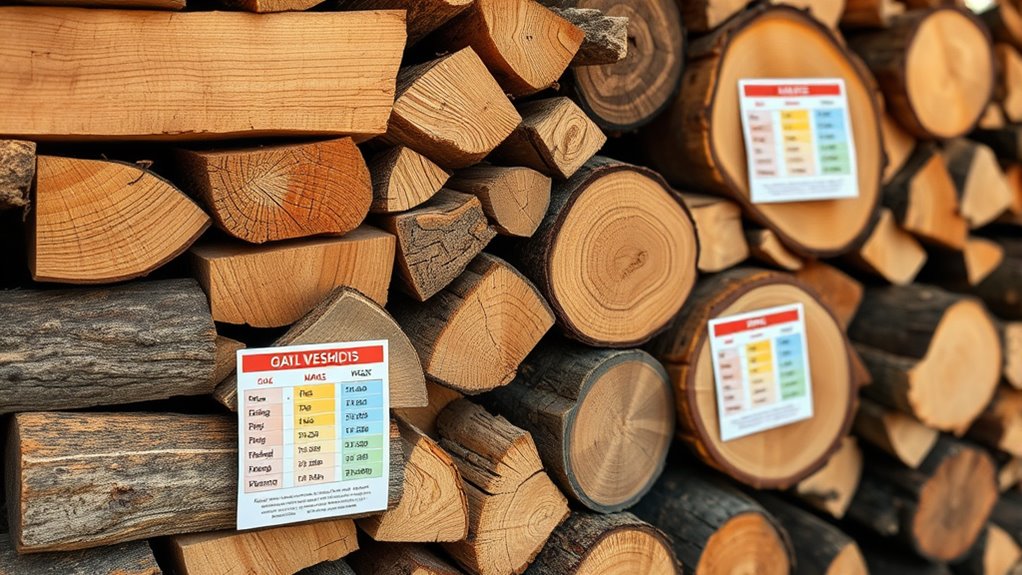
Different firewood species require specific handling and storage practices to maintain quality and safety. Proper firewood seasoning is essential to prevent mold and ensure efficient burning. When storing, keep firewood off the ground to avoid moisture absorption and pests. Use a covered, well-ventilated shed or stack wood in a crisscross pattern for airflow.
Properly seasoned firewood stored off the ground ensures safety, quality, and efficient burning.
Here are some storage tips to keep your firewood in top shape:
- Stack firewood neatly, leaving space between logs for air circulation.
- Cover the top of the stack with a waterproof tarp, but leave sides open.
- Store different species separately, especially hardwoods like oak and softer woods like pine, to avoid cross-contamination.
Following these tips helps preserve your firewood’s weight, quality, and safety.
Environmental Factors Influencing Firewood Weight

Environmental factors such as moisture levels, temperature, and airflow considerably impact the weight of firewood. Proper firewood seasoning removes excess moisture, reducing weight and making it easier to handle and burn efficiently. If firewood isn’t properly seasoned, it retains more water, increasing its weight and decreasing its heat output. Temperature fluctuations and airflow in your woodland ecosystem also influence how quickly firewood dries and loses moisture. In damp or poorly ventilated areas, wood may stay wetter longer, adding to its weight. Conversely, dry, well-ventilated environments promote effective seasoning. Understanding these environmental factors helps you predict firewood weight more accurately, ensuring safe handling and best burning. Recognizing the role of firewood seasoning and ecosystem conditions helps you manage your firewood supply more effectively.
Practical Examples of Firewood Weight Calculations

Understanding how environmental factors affect firewood moisture content helps you estimate its weight more accurately. For example, if you’re storing wood seasonally, higher moisture increases weight, making calculations essential for proper storage planning. Suppose you have a cord of oak:
- You measure the volume and determine it’s 128 cubic feet.
- Using the species’ average weight per cubic foot, say 45 pounds, you multiply to get about 5,760 pounds.
- Adjust for moisture content: if the wood is green, add 20-30% more weight.
This helps you plan seasonal storage, ensuring enough space, and aids pest control by keeping firewood dry and less prone to pests. Accurate weight calculations prevent surprises and optimize your firewood management, saving you time and effort.
Frequently Asked Questions
How Does Wood Density Vary Across Different Regions?
Regional density variations happen because climate impact influences how trees grow in different areas. Warmer, wetter regions usually produce denser wood, while colder or drier zones result in lighter, less dense wood. As you consider different regions, keep in mind that local climate factors shape wood’s density. So, understanding these regional differences helps you estimate wood weight and burning efficiency more accurately for your specific location.
Can Firewood Weight Affect Its Burning Efficiency?
Your firewood’s weight impacts its burning efficiency because heavier, denser wood burns longer and produces more heat. To maximize this, guarantee your firewood has proper moisture content; too wet, and it won’t burn well. Also, use good stacking techniques to promote airflow, helping the wood dry faster and burn more efficiently. Remember, properly seasoned, dense firewood with ideal moisture levels makes your fire burn hotter and cleaner.
Is Kiln-Dried Firewood Lighter Than Seasoned Wood?
Think of kiln-dried firewood as a lightweight feather compared to seasoned wood’s denser, more substantial feel. Kiln-dried wood has lower moisture content because it’s dried quickly in a controlled environment, making it lighter. Proper storage methods help maintain its dryness and weight advantage. So yes, kiln-dried firewood is typically lighter than seasoned wood, giving you easier handling and quicker ignition for a cozy fire.
How Do Species-Specific Pests Influence Firewood Weight?
Species-specific pests can considerably influence firewood weight through pest infestation, which often causes weight reduction. As pests burrow and consume the wood, they weaken its structure and reduce overall mass. You might notice lighter firewood after pest activity, making it less efficient for burning. Being aware of pest infestations helps you understand why some firewood weighs less, ensuring you select properly dried and pest-free wood for ideal performance.
What Safety Precautions Are Needed When Handling Heavy Firewood?
When handling heavy firewood, prioritize your safety with personal protective equipment like gloves and eye protection, and use safe lifting techniques to prevent injury. Always lift with your legs, not your back, keep the load close to your body, and ask for help when needed. Protect yourself by staying alert, maintaining good posture, and avoiding rushing. These precautions help prevent strains, cuts, and accidents, ensuring safe and efficient firewood handling.
Conclusion
Understanding firewood weight charts helps you make smarter choices, turning your woodpile into a well-balanced symphony of warmth. By knowing the densities and moisture impacts, you’re equipped to buy, sell, and store firewood with confidence—like a seasoned conductor guiding an orchestra. So, embrace these insights, and let your knowledge be the melody that guarantees every log you handle hits just the right note in your cozy home.
